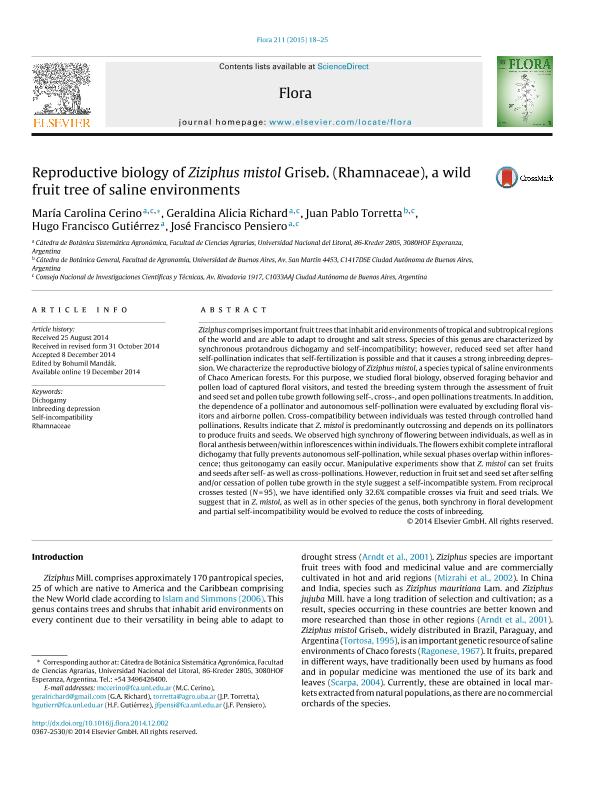Artículo
Reproductive biology of Ziziphus mistol Griseb. (Rhamnaceae), a wildfruit tree of saline environments
Cerino, María Carolina ; Richard, Geraldina Alicia
; Richard, Geraldina Alicia ; Torretta, Juan Pablo
; Torretta, Juan Pablo ; Gutiérrez, Hugo Francisco; Pensiero, Jose Francisco
; Gutiérrez, Hugo Francisco; Pensiero, Jose Francisco
 ; Richard, Geraldina Alicia
; Richard, Geraldina Alicia ; Torretta, Juan Pablo
; Torretta, Juan Pablo ; Gutiérrez, Hugo Francisco; Pensiero, Jose Francisco
; Gutiérrez, Hugo Francisco; Pensiero, Jose Francisco
Fecha de publicación:
12/2014
Editorial:
Elsevier Gmbh
Revista:
Flora
ISSN:
0367-2530
Idioma:
Inglés
Tipo de recurso:
Artículo publicado
Clasificación temática:
Resumen
Ziziphus comprises important fruit trees that inhabit arid environments of tropical and subtropical regions of the world and are able to adapt to drought and salt stress. Species of this genus are characterized by synchronous protandrous dichogamy and self-incompatibility; however, reduced seed set after hand self-pollination indicates that self-fertilization is possible and that it causes a strong inbreeding depression. We characterize the reproductive biology of Ziziphus mistol, a species typical of saline environments of Chaco American forests. For this purpose, we studied floral biology, observed foraging behavior and pollen load of captured floral visitors, and tested the breeding system through the assessment of fruit and seed set and pollen tube growth following self-, cross-, and open pollinations treatments. In addition, the dependence of a pollinator and autonomous self-pollination were evaluated by excluding floral visitors and airborne pollen. Cross-compatibility between individuals was tested through controlled hand pollinations. Results indicate that Z. mistol is predominantly outcrossing and depends on its pollinators to produce fruits and seeds. We observed high synchrony of flowering between individuals, as well as in floral anthesis between/within inflorescences within individuals. The flowers exhibit complete intrafloral dichogamy that fully prevents autonomous self-pollination, while sexual phases overlap within inflorescence; thus geitonogamy can easily occur. Manipulative experiments show that Z. mistol can set fruits and seeds after self- as well as cross-pollinations. However, reduction in fruit set and seed set after selfing and/or cessation of pollen tube growth in the style suggest a self-incompatible system. From reciprocal crosses tested (N=95), we have identified only 32.6% compatible crosses via fruit and seed trials. We suggest that in Z. mistol, as well as in other species of the genus, both synchrony in floral development and partial self-incompatibility would be evolved to reduce the costs of inbreeding.
Palabras clave:
Dichogamy
,
Inbreeding depression
,
Self-incompatibility
,
Rhamnaceae
Archivos asociados
Licencia
Identificadores
Colecciones
Articulos(CCT - SANTA FE)
Articulos de CTRO.CIENTIFICO TECNOL.CONICET - SANTA FE
Articulos de CTRO.CIENTIFICO TECNOL.CONICET - SANTA FE
Articulos(OCA PQUE. CENTENARIO)
Articulos de OFICINA DE COORDINACION ADMINISTRATIVA PQUE. CENTENARIO
Articulos de OFICINA DE COORDINACION ADMINISTRATIVA PQUE. CENTENARIO
Citación
Cerino, María Carolina; Richard, Geraldina Alicia; Torretta, Juan Pablo; Gutiérrez, Hugo Francisco; Pensiero, Jose Francisco; Reproductive biology of Ziziphus mistol Griseb. (Rhamnaceae), a wildfruit tree of saline environments; Elsevier Gmbh; Flora; 211; 12-2014; 18-25
Compartir
Altmétricas



